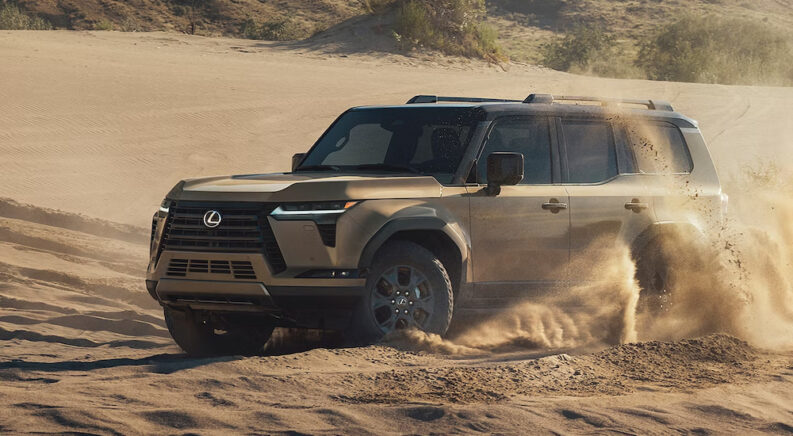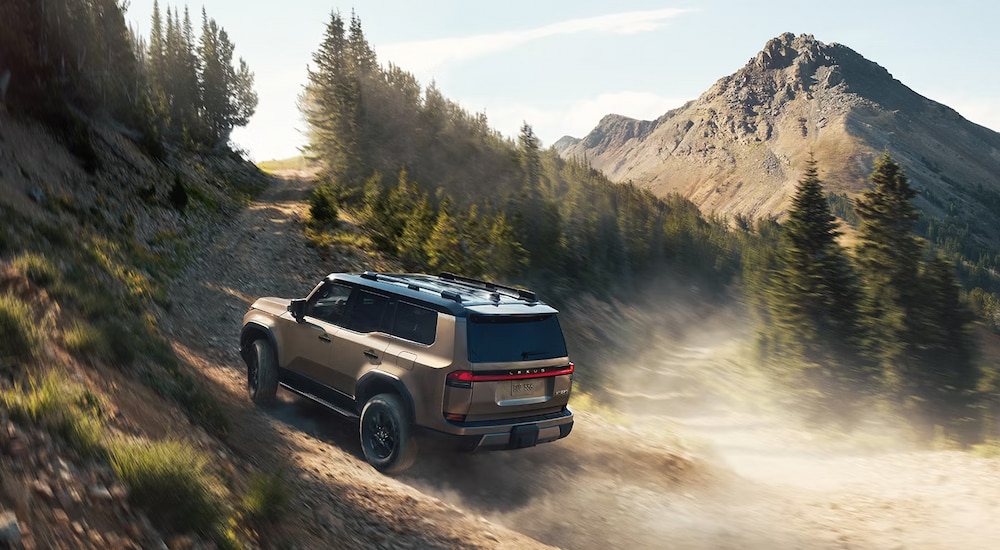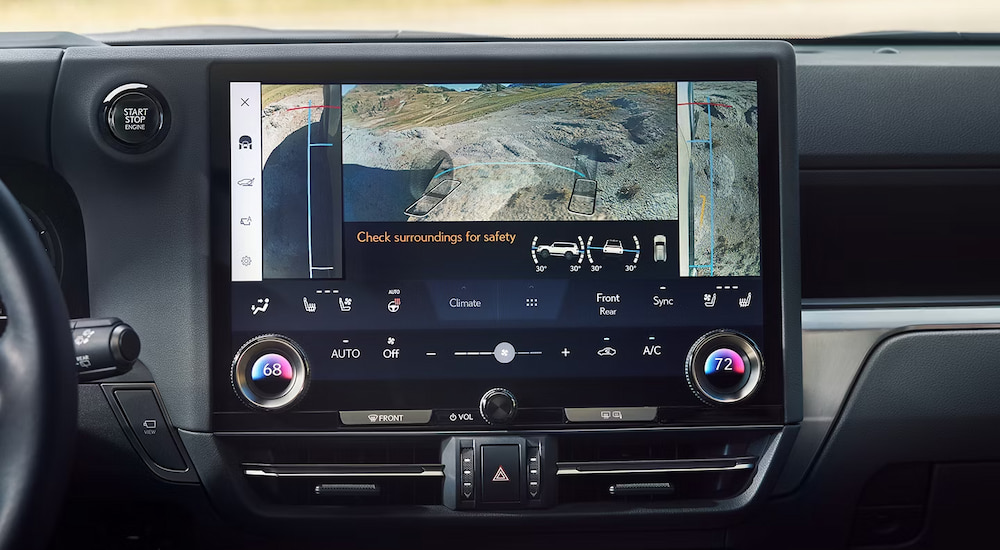The Lexus GX is back and better than ever for 2024 as the long-awaited third-generation model finally hits the streets. On top of the entirely new TNGA-F platform that the GX shares with the Toyota 4Runner and Land Cruiser, Lexus has also treated the GX to a new powertrain and a long list of safety, comfort, and convenience features that go a long way towards modernizing the midsize model. A new twin-turbocharged 3.4-liter V6 delivers 349 hp and 479 lb-ft of torque, which is a notable improvement over the 2023 version with its 301 hp and 329 lb-ft of torque.
There’s no doubting the GX’s credentials as far as on-road comfort and luxury are concerned, but it’s the SUV’s off-road credentials that really caught our attention this time around. Midsize SUVs have long been the go-to choice for those seeking a reliable off-road companion, something Lexus has clearly taken to heart when designing the all-new GX. The SUV features four-wheel drive as a standard feature across the entire lineup, but it’s the two off-road-focused trims that really make the GX a must-see model when you’re visiting your local Lexus dealer. Is the Lexus GX the best luxury off-roader on the market? Let’s take a deep dive into the two off-road trims, explore the advantages of the TNGA-F platform, and see how the Lexus GX has found so much success in the off-road luxury segment.
TNGA-F Platform
The Toyota New Global Architecture (TNGA) family of modular platforms has been steadily working its way into both Toyota and Lexus models since it was first introduced on the fourth-generation Prius in 2015. Designed to accommodate vehicles of different sizes and drivetrain designs, these platforms have drastically simplified Toyota’s manufacturing process. Now serving as the basis for over 80 percent of Toyota and Lexus models, the five TNGA platforms have allowed the manufacturers to reduce production costs by as much as 20 percent while maintaining the brands’ stellar reputation for reliability.
Designed specifically for midsize and full-size body-on-frame trucks and SUVs, the TNGA-F platform made its debut in 2021 with the release of the Toyota Land Cruiser, Toyota Tundra, and Lexus LX. The potent platform has since been extended to the Toyota Sequoia, Toyota Tacoma, Toyota 4Runner, and Lexus GX, serving as a rock-solid base onto which the two brands can build the off-road models of the future. A high-strength boxed, steel ladder frame serves as the basis for every TNGA-F model, accommodating such vital off-road equipment as multi-link coil spring rear suspension and double wishbone front suspensions to provide comfort and capability on any surface. One notable innovation comes in the form of the TNGA-F’s tailor welded blank (TWB) sections, which are composed of different types of steel of various thicknesses and surface treatments that are welded together and then press-molded into a single unit. This is a departure from the typical thick plate reinforcements found on older body-on-frame vehicles and provides a lightweight frame that makes no sacrifices in terms of rigidity or strength.
This brings us to one of the biggest debates in the modern SUV segment: unibody versus body-on-frame design. Unibody SUVs, also known as crossovers, feature a chassis and frame that’s created as one single unit, while body-on-frame models see the chassis and frame produced separately and then bolted together towards the end of the manufacturing process. The unibody approach boasts a number of advantages in terms of comfort and efficiency, but while there’s no denying the increasing popularity of the unibody design in today’s auto industry, it’s not always the right choice for every application. This is especially true of models designed with off-road adventure in mind. Venturing onto rocky, rugged terrain can do a number on a crossover SUV, which is why body-on-frame models tend to be the go-to in the off-road market.
The body-on-frame bias largely comes down to the fact that vehicles like the Lexus GX simply provide more flexibility than your average unibody vehicle. This is a crucial attribute when tackling the sort of rough, uneven terrain one is likely to encounter on their local off-road trails, giving a vehicle a better shot at resisting the sort of long-term damage that can come with such heavy-duty applications. While the frame of a unibody vehicle might start to warp or bend after a long day of off-road adventure, body-on-frame models can soak up the same sort of bumps and bruises with ease. In addition to making them more durable, this flexibility allows body-on-frame vehicles to achieve higher towing and payload capacities. Body-on-frame vehicles can also be cheaper to repair than their unibody counterparts, lowering the lifetime ownership costs of such vehicles.
Overtrail and Overtrail+ Trims
The Lexus GX provides a rare fusion of luxury and off-road performance, but there’s one important caveat to consider when you’re visiting your local Lexus dealer. While every version of the 2024 Lexus GX comes standard with the brawny 3.4-liter V6 engine, those seeking a readymade adventure rig should probably stick to the Overtrail and Overtrail+ trims. Designed with off-roading in mind, these two trims feature everything you need for a long day off the grid, from 33-inch all-terrain tires and an adaptive suspension system to some cutting-edge trail tech and more. The Overtrail and Overtrail+ trims do see the GX lose its third row of seating, but it’s a small price to pay for the kind of fun the off-road models can offer.
We’ll start by taking a closer look at the GX 550 Overtrail. In addition to the aforementioned 33-inch all-terrain tires, the trim is treated to a set of 18-inch six-spoke alloy wheels with a Dark Gray metallic finish that lends them a distinctive look. As far as off-road equipment is concerned, the Overtrail starts off strong with a Panoramic View Monitor with Multi-Terrain Monitor. Visibility is key when navigating the bumps, ruts, and obstacles that can come with off-road driving, but the Panoramic View Monitor with Multi-Terrain Monitor gives drivers a comprehensive look at their surroundings. Simply activate the Multi-Terrain Monitor, and you’ll be able to keep tabs on easy-to-miss areas around the vehicle from the comfort of the GX’s 14-inch infotainment display with unique perspectives, including Underfloor and Back Underfloor views.
The Overtrail trims also feature an electronically controlled locking rear differential for maximum traction, not to mention Lexus’ Electronic Kinetic Dynamic Suspension System (E-KDSS). This advanced suspension control system allows the SUV’s swaybars to automatically detach and reattach as needed, providing drivers with the sort of wheel articulation that’s necessary for overcoming boulders, logs, and other common off-road obstacles, as well as improving stability. The Overtrail trims are also packed with some impressive off-road technology like Crawl Control, Downhill Assist Control, and Lexus’ Multi-Terrain Select (MTS) system. Crawl Control is perfect for tackling tough terrain at lower speeds, automatically handling all throttle and braking duties so that drivers can focus on avoiding obstacles and keeping their GX firmly planted on the trail. The Overtrail and Overtrail+ trims are also surprisingly adaptable thanks to an electronic transfer case that can quickly switch between high-range and low-range settings. When in high range, MTS has four distinct settings with Auto, Dirt, Sand, Mud, and Deep Snow modes. Switching to Low Range swaps Deep Snow for Rock mode, which is perfect for tackling technical trails.
The ultimate Overtrail+ trim adds a few opulent luxury touches to the mix, from a 10-way power-adjustable heated and ventilated driver’s seat and front massaging seats to Intuitive Parking Assist with Auto Braking and Rear Pedestrian Detection. While these features might not add a lot in the way of off-road functionality, they should come in handy when braving the morning commute or navigating the wilds of your local grocery store parking lot. The two Overtrail trims also look the part, thanks to roof rails, skid plates, and some other important styling upgrades that set the off-roaders apart from the rest of the GX lineup.
Unbeatable Luxury Features and Off-Road Ability
The Lexus GX isn’t just one of the most luxurious midsize SUVs on the market; it’s also one of the most capable when it comes to off-road adventure. While a generation of so-called “soft-roaders” have diluted the meaning of the term off-road SUV, the Lexus GX represents a satisfying return to form. Instead of simply slapping a few sporty details and some all-terrain tires onto an existing model, Lexus has undertaken the exercise in earnest, crafting a well-rounded SUV that’s just as much at home chewing through mud, rocks, and sand as it is cruising down the highway. The new TNGA-F platform provides the perfect starting point for an off-road model with the sort of heavy-duty body-on-frame construction that will increase a driver’s confidence when the going gets tough. The Overtrail and Overtrail+ trims further enhance the SUV’s off-road resume, introducing a bevy of industrial-strength components and cutting-edge automation and safety tech while keeping the GX under $80,000. If you’re looking for an unbeatable combination of luxury features and off-road ability, the Lexus GX is here to serve.






